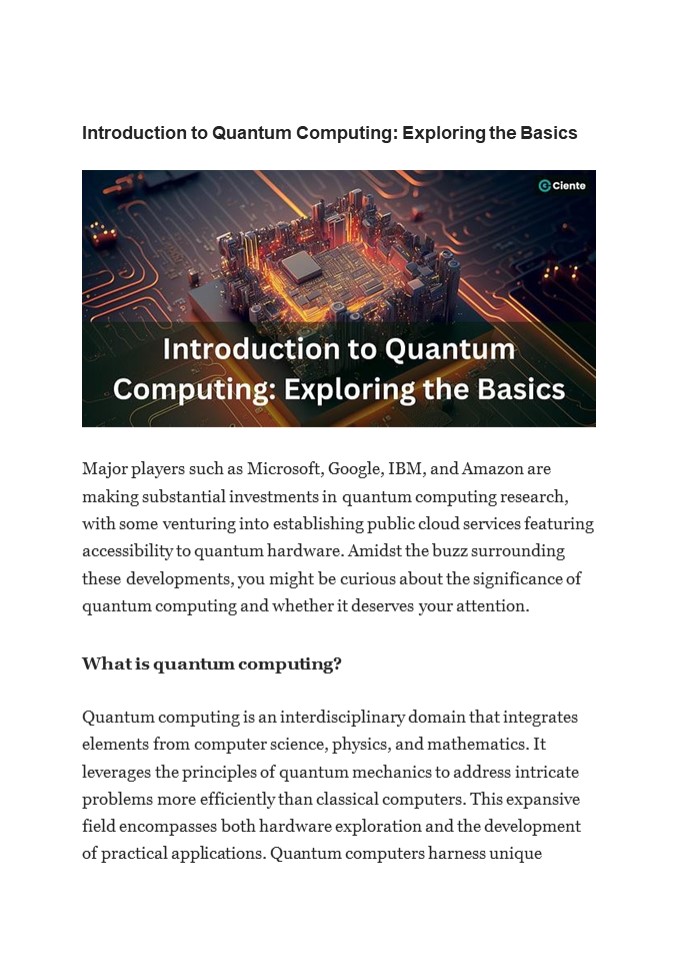Introduction to Quantum Computing: Exploring the Basics - PowerPoint PPT Presentation
Title:
Introduction to Quantum Computing: Exploring the Basics
Description:
Quantum computing, at its core, can be likened to conducting experiments with quantum objects and observing their behavior. – PowerPoint PPT presentation
Number of Views:1
Title: Introduction to Quantum Computing: Exploring the Basics
1
Introduction to Quantum Computing Exploring the
Basics
Major players such as Microsoft, Google, IBM, and
Amazon are making substantial investments in
quantum computing research, with some venturing
into establishing public cloud services featuring
accessibility to quantum hardware. Amidst the
buzz surrounding these developments, you might
be curious about the significance of quantum
computing and whether it deserves your
attention. What is quantum computing? Quantum
computing is an interdisciplinary domain that
integrates elements from computer science,
physics, and mathematics. It leverages the
principles of quantum mechanics to address
intricate problems more efficiently than
classical computers. This expansive field
encompasses both hardware exploration and the
development of practical applications. Quantum
computers harness unique
2
- quantum mechanical phenomena, such as
superposition and quantum interference, to
expedite the resolution of specific problems.
Areas benefiting from this accelerated processing
include machine learning, optimization, and the
simulation of physical systems. Potential
applications extend to finance, such as portfolio
optimization, and the simulation of chemical
systems, pushing the boundaries of
problem-solving beyond the capabilities of even
the most powerful contemporary supercomputers. - What are the principles of quantum computing?
- A quantum computer operates based on principles
inherent to quantum mechanics, necessitating a
unique vocabulary for comprehensive
comprehension. This lexicon introduces terms like
superposition, entanglement, and decoherence,
each playing a crucial role in the functioning
of quantum computers. - Superposition In the realm of quantum mechanics,
superposition implies the ability to combine two
or more quantum states, analogous to classical
waves. The result is a valid quantum state, and
conversely, any quantum state can be expressed as
the sum of two or more distinct states. This
characteristic endows quantum computers with
inherent parallelism, enabling them to execute
myriad operations simultaneously. - Entanglement Quantum entanglement emerges when
two systems become intricately connected,
allowing knowledge about one system to
instantaneously reveal information about the
other, regardless of their physical separation.
Quantum processors
3
leverage entanglement to draw conclusions about
one particle by measuring another, establishing
correlations such as the inverse spin
relationship between entangled qubits. This
phenomenon empowers quantum computers to solve
complex problems at an accelerated pace. When a
quantum state undergoes measurement, the
wavefunction collapses, and the state is
determined as either a zero or a one, akin to a
classical bit. Entanglement signifies the
capacity of qubits to synchronize their states
with other qubits. 3. Decoherence Decoherence
denotes the dissipation of the quantum state
within a qubit. External factors, like radiation,
can induce the collapse of the quantum state in
qubits. Constructing a quantum computer poses a
significant engineering challenge, necessitating
the implementation of features designed to
mitigate decoherence. This includes specialized
structures that shield qubits from external
fields, with the objective of delaying the loss
of the quantum state. Conclusion Quantum
computing, at its core, can be likened to
conducting experiments with quantum objects and
observing their behavior. Given the nature of
probabilistic states, it becomes essential to
iterate the experiment multiple times to obtain a
precise distribution of outcomes. This approach
diverges significantly from classical computing
systems, yet it is undeniably a form of
computation. When tackling problems with a
quantum component, opting for a genuine quantum
4
experiment often proves more efficient than
attempting classical computations. The inherent
quantum aspects lend themselves to swifter and
more effective modeling through real quantum
experiments. AUTHOURS BIO With Ciente, business
leaders stay abreast of tech news and market
insights that help them level up now, Technology
spending is increasing, but so is buyers
remorse. We are here to change that. Founded on
truth, accuracy, and tech prowess, Ciente is
your go-to periodical for effective
decision-making. Our comprehensive editorial
coverage, market analysis, and tech insights
empower you to make smarter decisions to fuel
growth and innovation across your
enterprise. Let us help you navigate the rapidly
evolving world of technology and turn it to your
advantage.































